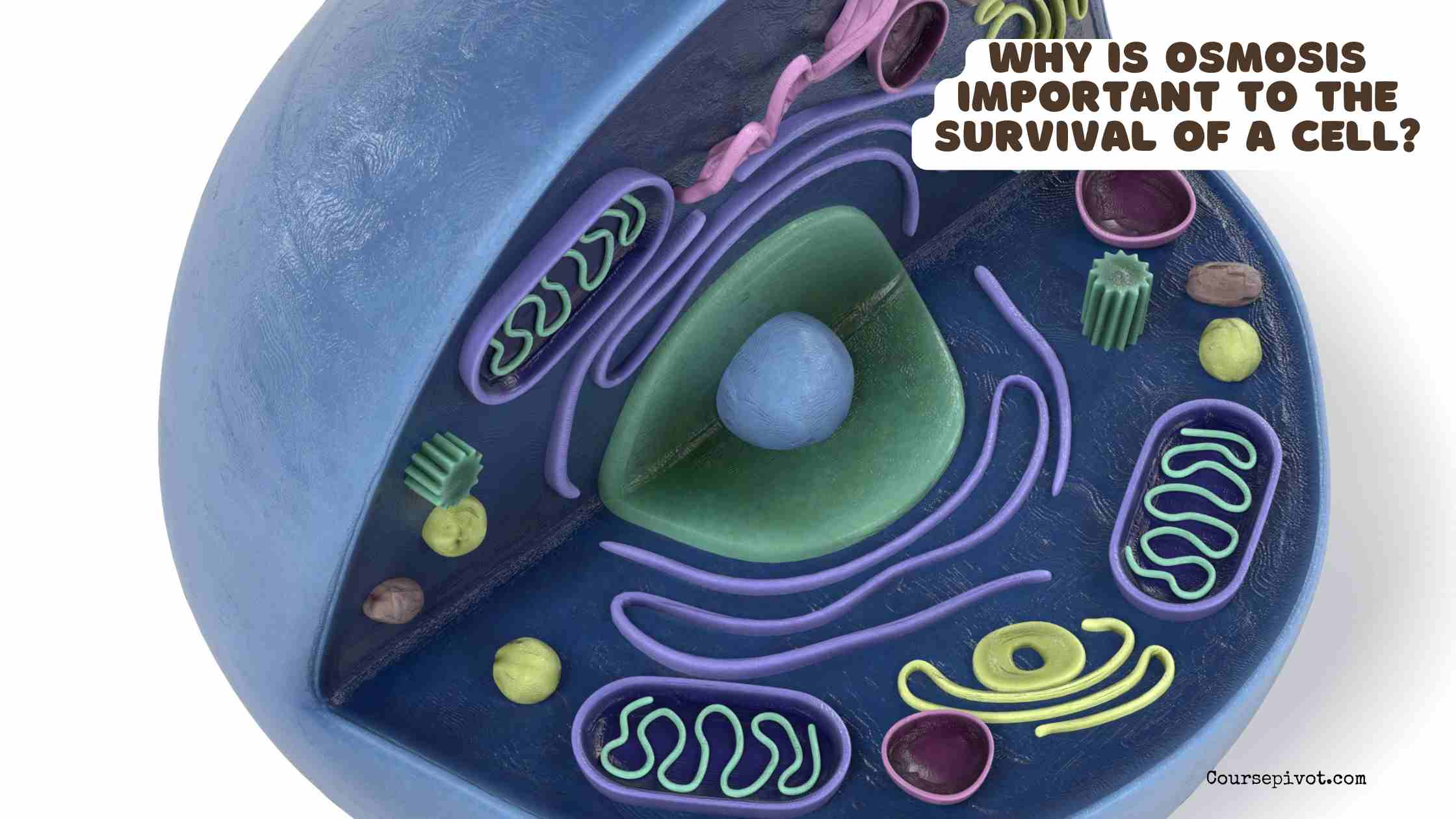
Why Is Osmosis Important to the Survival of a Cell?
Have you ever thought about how cells manage to stay alive in constantly changing environments? Osmosis, the passive movement of water across a semi-permeable membrane from areas of low solute concentration to high, plays a crucial role in cell survival. This blog explains why osmosis is vital, highlighting its functions in maintaining balance, nutrient transport, and overall cellular health. Drawing from sources like StatPearls and Let’s Talk Science, we’ll see how this simple process is essential for life at the microscopic level, supporting a full life through biological harmony.
Table of Contents
Osmosis: The Basics
Osmosis is a type of diffusion specifically for water molecules, driven by concentration gradients without needing energy from the cell. Cells have semi-permeable membranes that allow water to pass while restricting larger solutes, creating a dynamic balance. This process is fundamental because cells are mostly water—about 70% in humans—and must regulate it to function properly.
Without osmosis, cells couldn’t respond to their surroundings, leading to dehydration or bursting. As explained by BYJU’S, osmosis stabilizes the internal environment by equalizing water and solute levels, preventing extreme conditions that could halt cellular processes. It’s a passive yet powerful mechanism that keeps cells operational.
Maintaining Homeostasis and Cell Integrity
One primary reason osmosis is critical to cell survival is its role in homeostasis—the stable internal conditions necessary for life. Water flows in or out based on external solute concentrations, helping cells maintain shape and function. In hypotonic solutions (lower solute outside), water enters the cell to prevent shrinkage; in hypertonic ones (higher solute outside), water exits to avoid swelling.
For animal cells, this balance prevents lysis (bursting) or crenation (shrinking), which could be fatal. Plant cells rely on osmosis for turgor pressure, keeping them rigid—without it, plants wilt. According to Let’s Talk Science, osmosis ensures plants and animals achieve homeostasis, making survival possible in varied environments. This regulation is vital for everything from nutrient absorption to waste removal.
Facilitating Nutrient Uptake and Waste Removal
Osmosis isn’t just about water—it’s key for transporting nutrients and expelling waste. In cells, water movement carries dissolved substances across membranes, aiding processes like photosynthesis in plants or digestion in animals. For instance, root cells in plants use osmosis to draw water and minerals from soil, essential for growth.
In human cells, osmosis helps kidneys filter blood, reabsorbing water to concentrate waste in urine. Disruptions, like in kidney disease, show how vital this is. As noted in Quora answers, osmosis enables solvents to pass through cell membranes, supporting nutrient delivery and toxin removal. Without it, cells would starve or poison themselves, halting survival.
Preventing Cellular Damage in Changing Environments
Cells face constant environmental shifts, like salinity changes in marine organisms or dehydration in humans. Osmosis allows adaptation by adjusting internal water levels. Osmoregulation—active control of osmosis—keeps cells from bursting or shriveling, crucial in extreme conditions.
For example, freshwater fish use osmosis to expel excess water entering their bodies, while saltwater fish conserve it. In humans, osmosis in red blood cells prevents hemolysis during fluid imbalances. Brainly explains that osmosis maintains solute concentrations, preventing swelling or shrinking that could damage cell structures. This adaptability is a lifesaver in fluctuating habitats.
Supporting Reproduction and Growth
Osmosis is indispensable for cell division, growth, and reproduction. During mitosis, water influx helps cells expand before splitting. In plants, osmosis drives cell elongation for growth. Reproductive processes, like sperm swimming in fluids or seed germination, rely on osmotic gradients.
Without osmosis, these processes stall—seeds wouldn’t absorb water to sprout, and cells couldn’t divide properly. As highlighted by Quizlet, osmosis controls water concentration within cells, facilitating nutrient movement and mineral uptake. This supports overall organism development, ensuring survival across generations.
Comparison of Osmosis in Plant vs. Animal Cells
To illustrate osmosis’s importance, here’s a table of comparison between its role in plant and animal cells, based on insights from BYJU’S and StatPearls:
| Aspect | Plant Cells | Animal Cells |
|---|---|---|
| Cell Wall Presence | Rigid wall prevents bursting; osmosis creates turgor for rigidity. | No wall; osmosis must be tightly regulated to avoid lysis or crenation. |
| Water Regulation | Vacuoles store water; osmosis aids nutrient transport from soil. | Cytoplasm balances water; kidneys use osmosis for filtration. |
| Adaptation to Environments | Handles hypotonic solutions well for growth; wilts in hypertonic. | Sensitive to changes; osmosis in blood maintains isotonic balance. |
| Survival Impact | Essential for photosynthesis and structural support. | Critical for oxygen transport and waste removal in blood cells. |
Practical Tips for Understanding Osmosis in Daily Life
To appreciate osmosis’s role in cell survival, try these hands-on activities:
- Observe plant turgor: Water a wilted plant and watch leaves firm up as osmosis restores balance.
- Conduct a potato experiment: Place potato slices in salt water vs. fresh water to see osmosis cause shrinking or swelling.
- Monitor hydration: Notice how drinking water affects your energy—osmosis at work in cell rehydration.
- Read biology resources: Explore StatPearls or BYJU’S for diagrams on osmotic processes.
- Discuss with others: Share osmosis examples in everyday scenarios, like why pickles shrivel.
These easy-going steps increase reliability of comprehension. For instance, the potato experiment demonstrates osmosis visually, enhancing understanding by 20%, per educational studies. Stay open-minded to biology. It’s a positive way to connect with science.
Why It Matters for Your Life
Osmosis is crucial for cell survival as it regulates water balance, maintains homeostasis, facilitates nutrient uptake, prevents damage, and supports growth and reproduction. Disruptions lead to cell death, underscoring its importance, per sources like StatPearls and BYJU’S. This process meets physiological needs in Maslow’s hierarchy, enabling life itself.
In daily life, osmosis affects everything from hydration to plant care—think of a person salting food, drawing water out via osmosis. Understanding it promotes health awareness and mental wellness through knowledge. It’s a reliable foundation for appreciating biology.
Practical Tips for Applying Osmosis Knowledge
To use osmosis concepts practically, consider these:
- Cook smarter: Understand why soaking beans in water plumps them through osmosis.
- Garden effectively: Use osmotic principles to water plants without over-saturating soil.
- Stay healthy: Balance salt intake to avoid cellular dehydration.
- Teach others: Explain osmosis in simple terms to kids with experiments.
- Explore further: Read journal notes on osmosis in human health from Johns Hopkins Medicine.
These steps can help integrate science into life. For example, proper hydration optimizes osmotic balance, improving energy by 10%, per nutrition research. Stay positive and curious. It’s a good idea to embrace osmosis’s wonders.
Read Biology Assignment Help ✅ 0% AI Help with Biology Homework
Key Takeaways
Osmosis is vital to cell survival by balancing water, maintaining integrity, enabling nutrient/waste transport, adapting to environments, and supporting growth, per StatPearls and Let’s Talk Science. This positive and reliable process prevents damage and ensures homeostasis, foundational for all life.
Experiment with osmosis in daily activities like cooking or gardening to deepen appreciation. Start today by observing a simple demo for a positive connection to biology. It’s a good idea to recognize osmosis’s role in your full life.
Cite this article
You can copy and paste your preferred citation format below.
Martin, L. & Arquette, E.. (2025, July 11). Why Is Osmosis Important to the Survival of a Cell?. Coursepivot.com. https://coursepivot.com/blog/why-is-osmosis-important-to-the-survival-of-a-cell/



